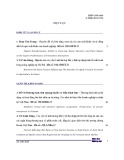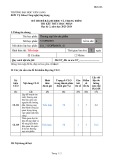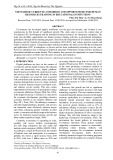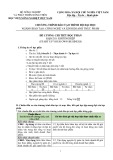
FTU Working Paper Series, Vol. 1 No. 1 (01/2022) | 93
ĐÁNH GIÁ NĂNG LỰC CẠNH TRANH CỦA NGÀNH THÉP VIỆT NAM
BẰNG MÔ HÌNH KIM CƯƠNG PORTER
Nguyễn Khánh Tùng1, Nguyễn Trung Kiên, Đinh Quang, Lê Nhật Hoàng
Sinh viên K58 CTTT Kinh t - Viện KT & KDQT
Trường Đại học Ngoại thương, Hà Nội, Việt Nam
Nguyễn Thu Hằng
Giảng viên Viện Kinh t và Kinh doanh Quốc t
Trường Đại học Ngoại thương, Hà Nội, Việt Nam
Tóm tắt
Do tác động ngày càng sâu sắc của đại dịch COVID-19 lên hoạt động kinh t toàn cầu, ngành thép
đã bộc lộ nhiều yu kém. Với đà tăng trưởng âm cùng nhu cầu thu mua không đảm bảo, mặt hàng
thép Việt Nam tỏ ra lép v hơn các nước khác trong khu vực, đặc biệt là những nơi được nhận nhiều
sự đầu tư hơn. Nghiên cứu này đánh giá năng lực cạnh tranh của ngành thép Việt Nam bằng việc
áp dụng mô hình kim cương Porter để phân tích dữ liệu định tính tới thời điểm năm 2021. Bài vit
đưa ra tổng quan về các tác nhân ảnh hưởng đn năng lực cạnh tranh của ngành thép Việt Nam và
những đề xuất về mặt chính sách tương ứng. Kt quả từ mô hình nghiên cứu đồng thời cũng chỉ ra
rằng ngành thép Việt Nam sở hữu những điều kiện thuận lợi để phát triển, song chưa tận dụng tối
đa tiềm lực công nghiệp để cạnh tranh ở thị trường nước ngoài. Tuy nhiên, Việt Nam có tiềm năng
trở thành một trong những quốc gia xuất khẩu thép chính trên thị trường th giới trong tương lai.
Từ khóa: Năng lực cạnh tranh, ngành thép, Việt Nam, mô hình kim cương.
AN ASSESSMENT OF THE COMPETITIVENESS OF VIETNAM'S STEEL
INDUSTRY USING PORTER'S DIAMOND MODEL
Abstract
Due to the rapidly evolving impacts of the Covid-19 pandemic on global economic activitíes, steel
market fundamentals have weakened seriously in recent years, with negative production growth,
uncertain prospects for demand growth, and the increase in new capacity investment in every region
except for Asia and the Middle East. This paper evaluates the competitiveness of Vietnam's steel
industry using Porter's Diamond model, analysing qualitative data covering the latest figures up to
2021. Based on the analysis, a critical overview of factors influencing competitiveness is presented,
and policy recommendations can be suggested. The results from the model also indicate that
Vietnamese steel, while still benefiting from specific conditions, has not profitably capitalised on
1 Tác giả liên hệ, Email: k58.1911400728@ftu.edu.vn
Working Paper 2022.1.1.07
- Vol 1, No 1

FTU Working Paper Series, Vol. 1 No. 1 (01/2022) | 94
its strengths to compete against rivals in overseas markets. However, there exists a potential for
Vietnam to become a key exporter in the future.
Keywords: Competitiveness, steel industry, Vietnam, Diamond model.
1. Introduction
Recent developments in steel have led to a renewed interest in Vietnam for over two decades,
and enterprises in the sector enjoyed a prosperous time over the first half of 2021. Production and
sales of steel products in Q12021 registered double-digit growth, and the figures were far higher
compared to previous estimates (Trinh, 2021). Many enterprises have invested heavily in
manufacturing high-quality products given their increased demand in foreign markets. As a result,
Vietnam's steel industry has made genuine progress in the region, which strengthens its position
in Southeast Asia as well as the global steel marketplace. (Duong, 2021).
Nevertheless, Vietnam's steel industry has long been recognised as a rather sensitive one. The
country is reported to have witnessed a challenging year for steel exports, due to the spread of
protectionist tendencies and trade remedies amongst foreign countries. Also, domestic rivalry and
international competition are rapidly growing. Since Vietnamese steel depends greatly on imported
raw input materials, global market trends have caused wide fluctuations in domestic steel prices
(Trinh, 2021).
Therefore, this research aims at addressing the following questions:
(1) What are the aspects of achieving a competitive advantage on the path of rapid steel
development in Vietnam, and how has the industry benefited from them?
(2) What disadvantages is Vietnam's steel industry experiencing, and what actions has the
government taken to overcome them?
In this paper, the comparative advantages of Vietnam's steel industry are studied to show how
competitive steel products exported from Vietnam are, regarding their market access in global and
regional trade, using Porter's Diamond model. Based upon the availability of information,
secondary data examined in the model is collected from 2007 to 2021 from reputable sources. The
rest of the paper is organized as follows: Section 2 presents the literature review; Section 3 puts
forward the research method employed; Section 4 describes and discusses the research outcomes.
Section 5 concludes Vietnamese steel export prospects towards the combination of government
regulations and situational elements.
2. Literature review
2.1. Porter's Diamond model
2.1.1. Concept of competitiveness on a national level
In respect of competitiveness on a national level, Stigler's (1988) definition of competition is
used as a fundamental principle: "Competition is a rivalry between individuals (or groups or
nations) and it arises whenever two or more parties strive for something that all cannot obtain". In
this modern changing marketplace, nations have their own competitive advantages (Porter, 1998).
Aldington Report (1985), Abdel-Latif (1993), Edwards and Schoer (2000) mentioned product
quality, innovation, design, distribution network, after-sales services, transaction costs,
institutional factors related to the bureaucracy of export procedures, and other non-price factors,
as the criteria for analysing a manufacturing firm's or industry's competitiveness. Lall (2001)
referred to national competitiveness as a major concern of policymakers in developing countries

FTU Working Paper Series, Vol. 1 No. 1 (01/2022) | 95
who intently keep track of indices ranking international competitive performance that rely on
integrating basic and associated factors.
2.1.2. Critics and extensions to Porter's Diamond framework
Porter's diamond framework has been widely criticised by international business scholars and
management theorists, who held that he has failed to develop a theory of national competitive
advantage. It is a theory just concerning how companies and sectors inside countries gain a
competitive advantage (Yetton et al., 1992). Rugman and D'cruz (1993) supported this argument,
maintaining that Porter undervalued the significance of multinational corporations and national
culture in the global economy, as well as the importance of technology (Oz, 2002). Furthermore,
the five-force concept has been attacked on the basis that the principal unit of analysis is the
industry rather than the individual firm, possibilities of applicability in MSMEs, the role of
domestic rivalry in the small economy (Clancy et al., 2001). Despite these flaws, this model is
widely recognized as the fundamental analytical framework of the 1980s competitive positioning
paradigm, and it is still used in most business school strategy classes today (Jin and Moon, 2006;
Esen and Uyar, 2012).
Several academics proposed revisions to Porter's single diamond framework and the concept
of double and multiple-linked diamonds, to reflect holistic competitive advantages (Liu and Hsu,
2009). For instance, Rugman and D'cruz (1993), Moon et al. (1998), and Jin and Moon (2006)
incorporate the effect of international activity. The international business scholars Rugman and
Verbeke (1993) and Asmussen et al. (2009) provided the groundwork for the creation of a new
paradigm for analyzing the various approaches to foreign subsidies and multinational strategic
management.
2.1.3. Using Porter's Diamond approach
Chung (2016) developed assessment criteria of logistics cluster competitiveness among Asian
nations based on Porter's diamond model, attributing a country's higher competitiveness to its
absolute advantage in logistics cluster indices. To analyze the comprehensive competitiveness of
China's coal industry, Wu et al. (2017) adopted the same model, mentioning factors such as excess
capacity, low price, and alternative sources of energy to affect the current performance of the
sector. Fang et al. (2018) utilized a revised diamond model to compare the international
competitiveness of G20 countries' renewable energy industry. By examining the geographical and
economic factors within the diamond theoretical framework, Da et al. (2020) showed that the
model is supported in explaining the export competitiveness of the agriculture sector from
emerging markets. Tsai et al. (2021) constructed an analytical framework that includes the six
dimensions of Porter's diamond model to enhance the creation of a theoretical framework and
suggest priorities for improving Taiwan's solar photovoltaic sector's competitiveness.
2.2. Qualitative research on the competitiveness developments of Vietnam's steel industry
Kawabata (2001) discussed the structure and policies of Vietnam's steel industry that affected
its competitiveness in the 1990s. Regarding steel competitiveness, Kawabata (2007) revealed that
a new phase has been affecting the competitiveness of Vietnamese steel and that a policy shift is
needed to fit the new phase after 2007. Kawabata (2016) discussed opportunities and challenges
for developing Vietnam's steel industry during the transition to a market-oriented economy and
indicated that economic reforms had benefited Vietnam's steel sector regarding more extensive
market selection, despite limitations such as overproduction and over-reliance on other sectors. In

FTU Working Paper Series, Vol. 1 No. 1 (01/2022) | 96
his latest study in 2018, Kawataba delved into the expansion of Vietnam's iron and steel sector
towards international economic integration, where private enterprises and foreign capital firms
have been prominent participants in the development.
Kiyong (2019) performed a detailed analysis of the outlook for sustained growth in Vietnam's
steel demand since the national economy was proliferating and the government directly financed
the construction of infrastructure and housing. Chen & Zhao (2016) showed that as the government
liberalizes investment regulations with less upfront capital, Vietnam's steel industry can enjoy
cheap labour costs and rapid development, while Dang and La (2020) focused on the protectionism
tariffs with evidence from the steel sector in Vietnam. Nguyen (2020) utilized Data Envelopment
Analysis (DEA) to analyze the business efficiency of steel enterprises from 2011 to 2019 and
concluded that the Hoa Sen Group and the Pomina Steel Corporation are prominent steel producers
but have not delivered efficient performance.
However, there has been no ex-ante research on the competitiveness of Vietnam's steel sector
using the complete Diamond model. Therefore, in this research, this model will be employed to
assess Vietnam's steel industry for a thorough understanding of the competitive advantages of
Vietnamese steel thanks to available factors, and how the government can help improve the export
opportunities of domestic enterprises.
3. Research method
This research makes use of Porter's Diamond Theory of National Advantage as an inductive
approach. By analysing qualitative data, the Porter's Diamond model is designed to assess the
competitive advantages that nations or groups gain under certain conditions readily available to
them, and explain how governments can act as a catalyst to improve a country's position in a
globally competitive economic environment.
Figure 1. Porter's Diamond Model
Source: Recommended
Internal and external factors that affect the competitive advantage of the domestic steel sector
are included in the model. Internal factors include factor conditions, demand conditions, firm
strategy, structure, rivalry, and related and supporting industries, which are positioned at four
corners of the model. Solid lines indicate mutual influences between internal factors. Factor
conditions are elements that an economy can create for itself, which are not easily susceptible to

FTU Working Paper Series, Vol. 1 No. 1 (01/2022) | 97
the imitation of other countries. Demand conditions allude to the size and nature of the customer
base for products in both the domestic and international markets. Related and supporting industries
refer to upstream and downstream industries that substantially impact the competitive edges of an
industry. Firm strategy, structure, and rivalry mean the existing industrial structure will adapt to
the corresponding changes in the external environment, and businesses in this industry create
coping methods. By contrast, the government and chance are the two most important external
influencing elements, which have reciprocal effects on internal factors, as demonstrated by the
dotted lines. The government's roles include raising competitiveness by stimulating early demand
for advanced products, focusing on specialized factor creations, promoting domestic competition,
and encouraging change. "Chance" alludes to random and unplanned events, such as war, natural
disasters, or scientific breakthroughs.
4. Results
4.1. Factor conditions
4.1.1. Natural resources
According to Steven (2019), Vietnam has a relatively large reserve of iron ore distributed
along the coast. Its geographical environment gives a natural advantage, namely hydrogeological
conditions, easy access to transportation, and centrally distributed mines. According to the
Vietnam Steel Association (VSA), the largest mines are located in Thach Khe, Ha Tinh, where a
deposit of more than 544 million tons is estimated, and Quy Xa, Lao Cai, where a deposit of 112
million tons is estimated (Hinh et al., 2013). However, plenty of iron ore is still being sold abroad,
leading to massive loss of value, while steel is imported from other nations at a high price.
Table 1: Distribution of iron ore resources in Vietnam
Region
Iron ore
reserves
Main types
of iron ore
Iron ore
grade
Main distributed areas
Northwest
More than 0.2
billion tons
Limonite,
magnetite
38-55%
Lao Cai, Yen Bai, Phu Tho,
Vinh Phuc
Northeast
More than 0.5
billion tons
Magnetite,
goethite
42-60%
Ha Giang, Thai Nguyen,
Cao Bang, Bac Kan, Tuyen
Quang
Central-north
More than 0.8
billion tons
Magnetite
60-65%
Thanh Hoa, Hoa Binh,
Nghe An, Ha Tinh
South
0.05 billion
tons
Magnetite
N/A
Dong Nai, Ba Ria Vung
Tau
Source: HXJQ Corporation
Taking into account its limited land area, Vietnam has a substantial resource of iron ore which
is primarily reserved in the country's northern regions, with proven reserves of 1.3 billion tons and
total reserves of 2.3 billion tons, with an iron ore quality of 50-65% (Steven, 2019). On the other
hand, Vietnam is a significant importer of low and medium-grade steel from Japan, as well as even
lower-grade steel from China, the Russian Federation, and Ukraine, implying that the market for
high-grade steel is restricted (Hinh et al., 2013).



![Đề thi Giao tiếp trong kinh doanh học kì 3 năm 2021-2022 có đáp án [kèm đề thi]](https://cdn.tailieu.vn/images/document/thumbnail/2025/20250409/gaupanda086/135x160/5071744187387.jpg)






















